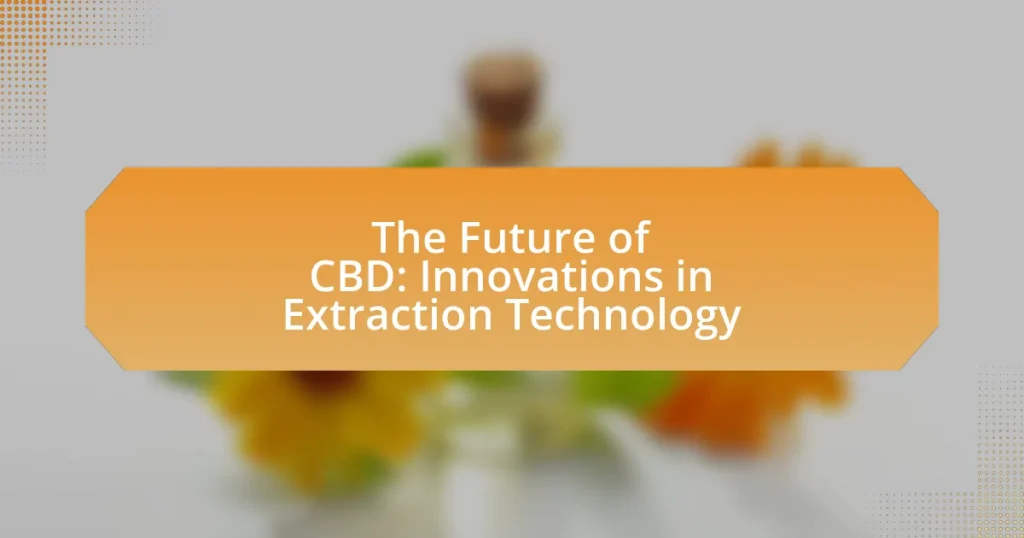The article focuses on the future of CBD extraction technology, highlighting current trends, innovations, and the impact of consumer preferences and regulatory changes on extraction methods. Key advancements include the increasing use of supercritical CO2 extraction and solventless techniques, which enhance purity and sustainability. The article also discusses how automation and artificial intelligence are improving efficiency and reducing operational costs, while addressing challenges such as regulatory compliance and scalability. Additionally, it emphasizes the importance of maintaining high product quality and the environmental implications of extraction processes.

What are the current trends in CBD extraction technology?
Current trends in CBD extraction technology include the increasing use of supercritical CO2 extraction, which is favored for its efficiency and ability to produce high-quality extracts without harmful solvents. This method allows for precise control over temperature and pressure, resulting in a cleaner product with a broader range of cannabinoids and terpenes. Additionally, advancements in solventless extraction techniques, such as rosin pressing and ice water extraction, are gaining popularity due to their ability to produce pure extracts without chemical solvents. Furthermore, the integration of automation and artificial intelligence in extraction processes is enhancing efficiency and consistency, leading to higher yields and reduced operational costs. These trends reflect a growing emphasis on sustainability and product quality in the CBD industry.
How is the demand for CBD influencing extraction methods?
The increasing demand for CBD is driving innovation in extraction methods to enhance efficiency and yield. As consumer interest in CBD products rises, manufacturers are adopting advanced techniques such as supercritical CO2 extraction and ethanol extraction, which provide higher purity and potency levels. For instance, supercritical CO2 extraction allows for precise control over temperature and pressure, resulting in a cleaner product with minimal residual solvents. This shift towards more sophisticated extraction methods is also supported by market research indicating that the global CBD market is projected to reach $47.22 billion by 2028, prompting companies to invest in technologies that optimize extraction processes and meet consumer expectations for quality and safety.
What consumer preferences are shaping extraction technology?
Consumer preferences shaping extraction technology include a demand for higher purity, sustainability, and efficiency in CBD products. Consumers increasingly prioritize products that are free from contaminants and possess a higher concentration of active compounds, leading to advancements in extraction methods that enhance purity levels. Additionally, there is a growing preference for environmentally friendly practices, prompting companies to adopt sustainable extraction techniques, such as CO2 extraction, which minimizes ecological impact. Furthermore, consumers favor extraction technologies that maximize yield and reduce production costs, driving innovation in methods that optimize efficiency while maintaining product quality. These preferences are supported by market research indicating that 70% of consumers are willing to pay more for sustainably sourced products, highlighting the importance of aligning extraction technology with consumer values.
How do regulatory changes impact extraction methods?
Regulatory changes significantly impact extraction methods by dictating the legal parameters within which these methods can operate. For instance, stricter regulations on solvent use can lead to the adoption of safer, more environmentally friendly extraction techniques, such as supercritical CO2 extraction, which is compliant with health and safety standards. Additionally, changes in regulations regarding the purity and potency of CBD products can necessitate advancements in extraction technology to ensure compliance, thereby influencing the choice of extraction methods. Historical data shows that following the 2018 Farm Bill in the United States, which legalized hemp-derived CBD, there was a marked increase in the use of advanced extraction technologies to meet the rising demand for high-quality CBD products.
What innovations are emerging in CBD extraction technology?
Emerging innovations in CBD extraction technology include advanced methods such as supercritical CO2 extraction, ethanol extraction, and ultrasonic extraction. Supercritical CO2 extraction is gaining popularity due to its efficiency and ability to produce high-quality CBD without residual solvents, as it operates at low temperatures and pressures. Ethanol extraction is also being refined to enhance yield and purity, utilizing techniques like cold ethanol extraction to minimize degradation of cannabinoids. Ultrasonic extraction is a newer method that employs sound waves to increase the efficiency of cannabinoid extraction, resulting in faster processing times and higher yields. These advancements are supported by research indicating that these methods can optimize extraction efficiency and product quality, making them increasingly favored in the CBD industry.
What are the latest advancements in CO2 extraction?
Recent advancements in CO2 extraction include the development of more efficient extraction methods, such as supercritical CO2 extraction with enhanced temperature and pressure controls, which improve yield and purity. Innovations in equipment design, like closed-loop systems and automated processes, have also increased extraction efficiency and reduced operational costs. Additionally, advancements in post-extraction processing techniques, such as winterization and distillation, have further refined the quality of extracted compounds. These improvements are supported by industry studies indicating that optimized CO2 extraction can yield higher concentrations of cannabinoids and terpenes, making it a preferred method in the CBD industry.
How is solventless extraction evolving in the CBD industry?
Solventless extraction is evolving in the CBD industry through advancements in technology and increased consumer demand for purity. Innovations such as heat and pressure techniques, including rosin extraction, have gained popularity due to their ability to produce high-quality CBD extracts without the use of solvents. According to a report by Grand View Research, the global CBD market is expected to reach $13.4 billion by 2028, indicating a significant shift towards cleaner extraction methods as consumers prioritize safety and quality. This evolution reflects a broader trend in the industry towards sustainable practices and transparency in product sourcing.

What are the benefits of advanced extraction technologies for CBD?
Advanced extraction technologies for CBD enhance the purity, yield, and efficiency of cannabinoid extraction. These technologies, such as supercritical CO2 extraction and ethanol extraction, allow for the precise targeting of desired compounds while minimizing the presence of unwanted substances. For instance, supercritical CO2 extraction operates at specific temperatures and pressures, resulting in a high-quality extract that retains the full spectrum of cannabinoids and terpenes, which is crucial for therapeutic efficacy. Additionally, these methods can achieve higher extraction yields compared to traditional techniques, thereby maximizing the output from raw materials. Studies have shown that advanced extraction methods can increase the concentration of CBD in the final product, making it more effective for consumers.
How do these technologies improve product quality?
Innovations in extraction technology improve product quality by enhancing the purity and potency of CBD extracts. Advanced methods, such as supercritical CO2 extraction, allow for precise control over temperature and pressure, resulting in higher yields of cannabinoids while minimizing the presence of unwanted compounds. Research indicates that supercritical CO2 extraction can achieve up to 90% purity in CBD products, significantly reducing contaminants compared to traditional methods. Additionally, these technologies enable the extraction of a broader spectrum of cannabinoids and terpenes, which contribute to the overall therapeutic effects and flavor profiles of CBD products, thereby elevating their quality and consumer satisfaction.
What role does extraction technology play in cannabinoid purity?
Extraction technology is crucial for ensuring cannabinoid purity by effectively isolating desired compounds while removing impurities. Advanced methods such as supercritical CO2 extraction and ethanol extraction allow for precise control over temperature and pressure, which helps maintain the integrity of cannabinoids and terpenes. Studies have shown that supercritical CO2 extraction can yield higher purity levels, often exceeding 90%, by selectively extracting cannabinoids without introducing harmful solvents or contaminants. This precision in extraction directly impacts the quality and safety of cannabinoid products, making extraction technology a key factor in achieving high purity levels.
How can extraction innovations enhance terpene preservation?
Extraction innovations can enhance terpene preservation by utilizing advanced techniques such as supercritical CO2 extraction and cold ethanol extraction. These methods operate at lower temperatures and pressures, which minimizes the degradation of sensitive terpenes during the extraction process. For instance, supercritical CO2 extraction allows for precise control over temperature and pressure, enabling the selective extraction of terpenes while preserving their aromatic profiles. Research indicates that these extraction methods can retain up to 90% of the original terpene content compared to traditional methods, which often result in significant losses due to heat and oxidation. This preservation of terpenes not only maintains the flavor and aroma of the final product but also enhances its therapeutic properties, as terpenes contribute to the entourage effect in CBD products.
What cost efficiencies can be achieved through new extraction methods?
New extraction methods can achieve significant cost efficiencies by reducing the amount of raw material needed and minimizing energy consumption. For instance, advanced techniques like supercritical CO2 extraction utilize less solvent and operate at lower temperatures compared to traditional methods, leading to lower operational costs. Additionally, these methods can enhance yield rates, allowing producers to extract more CBD from the same quantity of plant material, which further decreases the cost per unit of product. Research indicates that supercritical CO2 extraction can increase yield by up to 20% compared to ethanol extraction, demonstrating a clear financial advantage.
How do advanced technologies reduce operational costs?
Advanced technologies reduce operational costs by automating processes, improving efficiency, and minimizing waste. For instance, in the CBD extraction industry, advanced methods such as supercritical CO2 extraction and ethanol extraction streamline the extraction process, leading to higher yields and lower energy consumption. According to a study by the National Institute of Standards and Technology, these technologies can reduce extraction time by up to 50%, significantly lowering labor costs and resource usage. Additionally, real-time monitoring and data analytics enable companies to optimize their operations, further decreasing operational expenses.
What is the impact of automation on extraction processes?
Automation significantly enhances extraction processes by increasing efficiency, precision, and consistency. Automated systems can operate continuously, reducing the time required for extraction and minimizing human error. For instance, automated extraction equipment can optimize parameters such as temperature and pressure, leading to higher yields and better quality of extracted compounds. According to a study published in the Journal of Industrial and Engineering Chemistry, automation in extraction processes can improve productivity by up to 30% while ensuring uniformity in product quality. This technological advancement not only streamlines operations but also reduces labor costs and enhances safety by minimizing human involvement in potentially hazardous environments.

What challenges are faced in the future of CBD extraction technology?
The future of CBD extraction technology faces several challenges, including regulatory hurdles, scalability issues, and the need for cost-effective methods. Regulatory frameworks vary significantly across regions, complicating compliance for manufacturers and potentially stifling innovation. Scalability remains a concern as current extraction methods may not efficiently meet increasing consumer demand, particularly in markets experiencing rapid growth. Additionally, the pursuit of cost-effective extraction techniques is essential, as high operational costs can limit market accessibility and profitability. These challenges must be addressed to ensure the sustainable development of CBD extraction technology.
What are the technical limitations of current extraction methods?
Current extraction methods for CBD face several technical limitations, including inefficiency, scalability issues, and the potential for residual solvents. These methods often require extensive processing time and energy, leading to higher operational costs. For instance, traditional solvent extraction can leave behind harmful residues, which may compromise product safety and quality. Additionally, many extraction techniques struggle to maintain the integrity of sensitive compounds, resulting in lower yields and diminished therapeutic properties. These limitations highlight the need for advancements in extraction technology to enhance efficiency, safety, and product quality in the CBD industry.
How do scalability issues affect the adoption of new technologies?
Scalability issues significantly hinder the adoption of new technologies by limiting their ability to meet increasing demand efficiently. When a technology cannot scale effectively, it often results in higher costs, slower production rates, and inadequate performance under load, which can deter businesses from implementing it. For instance, in the context of CBD extraction technologies, if a method cannot be scaled to produce larger quantities without compromising quality or increasing operational costs, companies may opt for more established, scalable alternatives. This reluctance is supported by industry reports indicating that scalability is a critical factor in technology adoption, as businesses prioritize solutions that can grow alongside their needs without substantial investment in new infrastructure.
What are the environmental concerns associated with extraction processes?
Extraction processes raise significant environmental concerns, primarily including habitat destruction, water pollution, and carbon emissions. Habitat destruction occurs as land is cleared for extraction activities, leading to loss of biodiversity and disruption of ecosystems. Water pollution is a critical issue, as chemicals used in extraction can contaminate local water sources, affecting aquatic life and human health. Additionally, extraction processes often contribute to carbon emissions, exacerbating climate change. For instance, the extraction of fossil fuels is linked to substantial greenhouse gas emissions, with the International Energy Agency reporting that oil and gas extraction alone accounted for approximately 40% of global energy-related CO2 emissions in 2020. These environmental impacts highlight the need for sustainable practices in extraction technologies.
How can companies overcome regulatory hurdles in extraction technology?
Companies can overcome regulatory hurdles in extraction technology by implementing comprehensive compliance strategies that align with local and international regulations. These strategies include conducting thorough research on applicable laws, engaging with regulatory bodies early in the development process, and investing in legal expertise to navigate complex regulatory landscapes. For instance, companies that have successfully launched CBD products often collaborate with legal consultants to ensure adherence to the Food and Drug Administration (FDA) guidelines and state-specific regulations, which can vary significantly. Additionally, maintaining transparency in sourcing and production processes can build trust with regulators and consumers alike, further facilitating smoother compliance.
What strategies can be employed to navigate compliance challenges?
To navigate compliance challenges in the CBD industry, companies can implement a multi-faceted approach that includes staying informed about regulations, investing in compliance technology, and fostering a culture of transparency. Staying informed about evolving regulations is crucial, as the legal landscape for CBD is constantly changing; for instance, the 2018 Farm Bill legalized hemp-derived CBD but left many state-specific regulations in place. Investing in compliance technology, such as software that tracks regulatory changes and automates reporting, can streamline adherence to laws and reduce the risk of violations. Additionally, fostering a culture of transparency within the organization encourages employees to prioritize compliance and report potential issues, thereby minimizing risks associated with non-compliance. These strategies collectively enhance a company’s ability to navigate the complex compliance landscape effectively.
How can industry collaboration facilitate regulatory advancements?
Industry collaboration can facilitate regulatory advancements by enabling stakeholders to share knowledge, resources, and best practices, which can lead to more informed and effective regulatory frameworks. For instance, when companies in the CBD sector collaborate with regulatory bodies, they can provide empirical data on extraction technologies and product safety, which can help regulators understand the complexities of the industry. This collaboration can result in the development of standardized guidelines that ensure product quality and consumer safety, ultimately leading to more streamlined regulatory processes. Historical examples, such as the collaboration between the cannabis industry and state regulators in California, have shown that joint efforts can lead to clearer regulations and faster approval times for new products.
What practical tips can enhance the effectiveness of CBD extraction?
To enhance the effectiveness of CBD extraction, utilizing high-quality starting materials is essential. Selecting organically grown hemp with a high cannabinoid profile ensures a more potent extraction. Additionally, optimizing extraction parameters such as temperature and pressure can significantly improve yield and purity. For instance, using supercritical CO2 extraction at precise temperatures (around 35-40°C) and pressures (around 1000 psi) maximizes cannabinoid extraction while minimizing unwanted compounds. Furthermore, employing advanced techniques like ultrasonic extraction can increase efficiency by enhancing solvent penetration into plant material, leading to higher extraction rates.
How can producers optimize their extraction processes for better yields?
Producers can optimize their extraction processes for better yields by implementing advanced extraction technologies such as supercritical CO2 extraction, which enhances the efficiency and purity of the extracted compounds. This method allows for precise control over temperature and pressure, resulting in higher extraction rates and better preservation of sensitive cannabinoids and terpenes. Studies have shown that supercritical CO2 extraction can yield up to 90% of the desired compounds, significantly improving overall productivity compared to traditional methods like solvent extraction, which typically yield around 60-70%.
What best practices should be followed for maintaining equipment?
Regular maintenance of equipment is essential for optimal performance and longevity. Best practices include conducting routine inspections to identify wear and tear, adhering to manufacturer guidelines for servicing, and ensuring proper cleaning to prevent contamination. Additionally, maintaining accurate records of maintenance activities helps track performance and schedule future servicing. Implementing these practices can significantly reduce downtime and enhance the efficiency of extraction technology used in CBD production.



